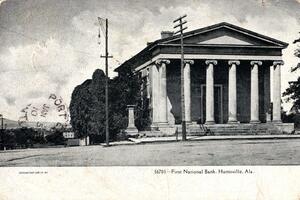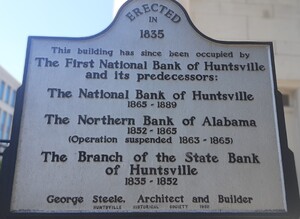
The First National Bank, 216 West Side Square
Emma Brownbridge, Fall 2024
The First National Bank, originally the Branch Bank of the State of Alabama, is the oldest continuously used bank in the state. Stationed at the corner of West Side Square formerly named Bank Row, it looks over the Spring which was the original reason for the huntsville settlement. Throughout these 189 years there have been several predecessors to the first national bank.
The branch of Alabama State Bank System in Huntsville was built in 1835 by Mr. George Steele who was both the architect and the superintendent in building the bank. The walls were made two feet thick out of stone slabs quarried nearby, with stucco applied over top. The distinctive column bases, shafts and capitals were said to come from Baltimore, Maryland. Pulled by ox cart to the headwater of the Tennessee River floated down then barged to the site by the canal. The construction of the bank exceeded $76,000 in cost, and remains a fine example of the 19th century Greek revival architecture seen throughout northern Alabama.
During this era in Alabama the extensive use of credit allowed the State Bank system to flourish. So much so that in 1836 the Alabama legislature abolished direct taxes, instead using the banks to pay the operating expenses of the state government. Time soon revealed that the banks had overextended and excessive loans. All of the State bank systems continued to run until 1846 then were slowly restricted in activities. After the failure of the state banking systems and final liquidation in 1857, the structure was taken over by the Northern Bank of Alabama.
The Northern Bank of Alabama operated from 1857 to 1865. But was disrupted during the civil war in 1862 when huntsville was occupied by the federal troops. The structure was used as a commissary for the soldiers. During this time period there is a story of the cashier taking all the liquid assets of the bank, hiding them in the lower part of a chimney in the bank. And it was the soldiers' pastime to try and find the liquid assets.
After the end of the war in 1865 the National Bank of Huntsville was authorized to open for business. The National Bank of Huntsville rented the structure for the first year, then leased it in 1866, and finally bought the structure in 1867 for $30,000. The First National Bank of Huntsville was organized for the purpose of taking over the The National Bank of Huntsville business and in July of 1889 the organization changed its name.
Hundred and fifteen years after the establishment of this structure and its many predecessors the director and officers of First National Bank of Huntsville recognizing the significance the bank had in the community and historic importance it had, created a modeling policy the stated: “Outwardly to retain all of the Old; Inwardly to make our Banking home as convenient, as comfortable and as modern as present day methods would permit”.
Thus far this policy has been maintained even with the various alterations made to the interior of the bank. The first being renovation to the second floor where the casher’s resistance once was due to state law requirements then tradition. This living area was converted to a conference room and offices. Another key thing that was first altered and then replaced is the vault. The original vault had walls created out of six feet thick limestone with a foot of space around the outside of that then a brick wall that was designed to protect in case of fire to prevent the heat and water from cracking the limestone. This was later reinforced with an inner compartment secured by a steel door and combination lock. Later the whole vault was removed and a new one was built in the back of the enlarged room. The new vault contained the modern safeguards to protect the assets of the bank and its customers.
Not only have the insides of the bank changed but so has the soundings and context of the bank. There are two key changes that alter the context of the bank. The bank overlooks the first change being the transition of city water works into what is now known as Big Spring park. The change from a utility to recreation that displays the historic significance of the canal in Huntsville history. The second key change is the remodeling of the court house across the street from the bank. The change from Greek revival style architecture to a more modern office style building displays the shift to a more scientific population, and the overall growth of the city. The change of the Courthouse and the Spring in contrast to the unchanged architecture of the bank shows the historical significance the bank still holds.


